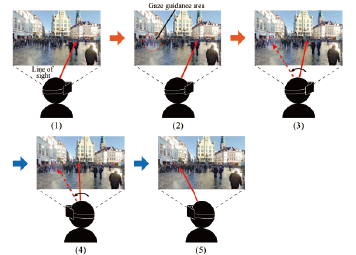Virtual Reality (VR) 環境においてユーザは Head Mounted Display (HMD) を用いることで, VR 環境内で任意の方向に視線を向けられる.一方で, VR コンテンツの制作者が注目して欲しい対象として設定したものをユーザが見るとは限らない.制作者が意図した VR 体験をユーザに提供するためには, VR 環境上で見せたいイベントやオブジェクトの方向へユーザの視線を自然に誘導する必要がある.本研究では, VR コンテンツにおいてユーザ体験を阻害せず,事後処理で容易に導入可能な視線誘導手法を検討する. 360◦ 映像では HMD の視野外への視線誘導を行いたい場合も考えられるが,本研究ではまず HMD の視野内で既に見えている箇所への視線誘導について検討する.本論文では 2 つの視線誘導手法を提案する. 1 つ目はぼかし制御を応用した視線誘導手法である. 2 つ目は明度の緩やかな動的変調と,誘導先への視線の接近による変調消失という 2 つの要素を組み合わせた視線誘導手法である.この 2 つの視線誘導手法をそれぞれ実装して効果検証を行い,ユーザ体験を妨げない視線誘導としての有効性を考察した. 1 つ目のぼかし制御を用いた視線誘導の効果検証実験では,バーチャル空間上でぼかし制御を行った場合,視線は鮮明な部分に向きやすくなることや,斜め方向に視線誘導を行う際は,より強く視線誘導を行う必要があることが分かった.また,視線誘導の成功回数が多かったグループはぼかしに対して不快感を感じられにくいことが示された. 2 つ目の手法では,明度の緩やかな動的変調により一定の視線誘導効果を保ちながら,被験者の視線誘導に対する違和感や不快感を有意に低減できた.変調が消失する条件では細かな視線誘導はできていなかったものの誘導先周辺への視線誘導は行えていた.また 360◦ 画像の違いによって各条件の視線誘導効果やアンケート結果に有意差はほとんどなかった.
Recent years have seen the widespread use of 360◦ video, which allows a user to look in any direction in the virtual space using a head-mounted display (HMD). On the other hand, users do not always see the specific contents that the creators want them to focus on. For the creators to provide users with the immersive experience they intend, it is necessary to naturally guide the user’s gaze to relevant spots in the virtual space. In this study, we investigate a gaze guidance method that does not interfere with the user’s experience of VR contents and can be easily introduced by post-processing. For 360◦ images, there may be cases where it might be required to guide the user’s gaze outside their field of view, but in this study, we first consider guiding the user’s gaze to spots that are already visible in their field of view. In this paper, we propose two gaze guidance methods. The first is a gaze guidance method based on blur control. The second is a gaze guidance method combining two techniques; gradual brightness modulation and termination of modulation as the gaze approaches the guidance area. Thus, we implemented each of the two gaze-guidance methods and validated their effectiveness in terms of how well they does not interfere with the user experience. In the experiment to verify the effect of the first method, it was found that when blur control was applied in the virtual space, the gaze tended to be directed to clear areas and that it was necessary to guide the gaze more strongly when guiding the gaze diagonally. Also, the group with more successful gaze guidance was less likely to feel uncomfortable with the blur. In the experiment to verify the effect of the second method, the results show that the gradual modulation, compared to the sudden modulation, significantly contributes to a more natural and less disturbing viewing experience while maintaining relatively high guidance performance. Terminating modulation as the gaze approaches is also helpful for natural viewing so that the viewers feel more weakly that they have to look at the guidance area. In the condition in which the modulation terminated, we were not able to guide the gaze in detail, but we were able to guide it around the guidance area. Also, there was almost no significant difference in the gaze guidance effect and questionnaire results for each condition depending on the 360◦ images.

